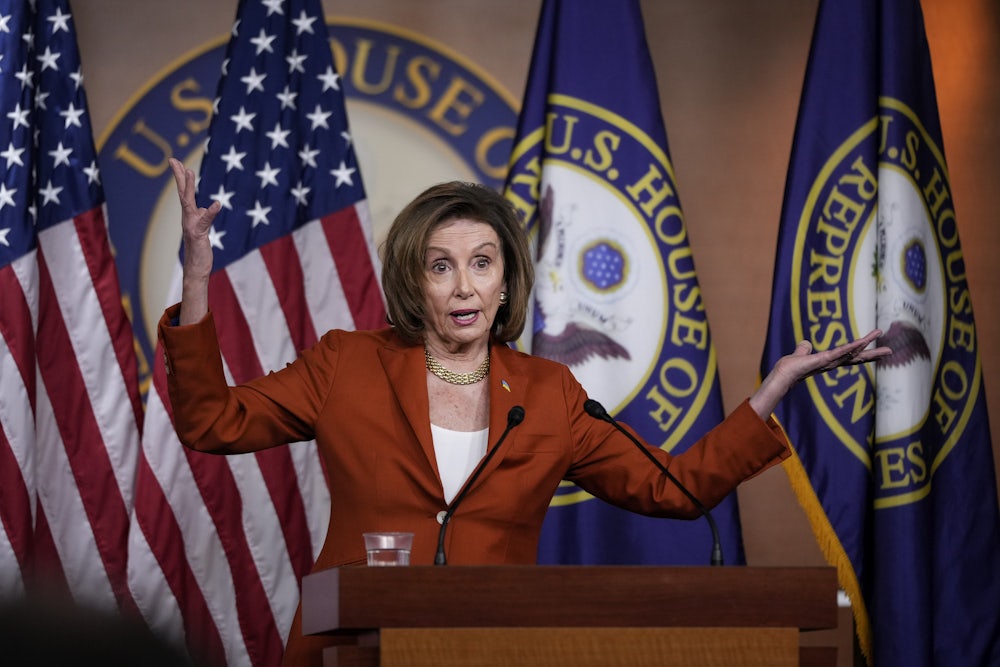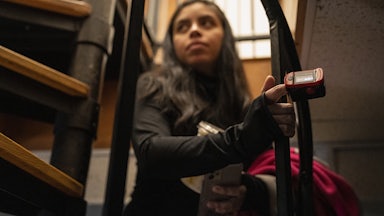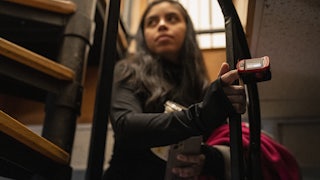This month marks the two-year anniversary of the coronavirus pandemic disrupting our lives and livelihoods, the abrupt transition from everyday existence to quarantine, and a new political reality that wishful thinking could not scrub away. Nearly one million deaths later—a loss that once seemed impossible but is now inevitable—politicians are eager to proclaim a return to normal for an exhausted public. After the stress of the omicron variant surge early this year, mask and vaccine mandates are now falling away in every state, and schools are fully open for children traumatized by two years of at-home and hybrid learning.
But despite the collective desire to move on, the pandemic is not over. Roughly one thousand people are still dying of the virus per day, and Covid-19 is the third-leading cause of death in the United States. Only 65 percent of the population is fully vaccinated, and 44 percent have received booster shots. Children under the age of 5 are still ineligible to receive vaccines. Millions of immunocompromised Americans must now navigate a reopened society, and the full effects of so-called “long Covid” are still unknown. The coronavirus is not yet endemic, the stage that would mean the virus is constantly present but manageable, like the seasonal flu. Far from receding, in fact, cases are once again on the rise in Europe because of the BA.2, or “stealth” omicron variant, which the White House on Monday acknowledged has begun to circulate in the U.S.; Europe has long foreshadowed our own pandemic trends.
President Joe Biden said in his State of the Union address this month that “Covid-19 no longer need control our lives.” But the White House is nonetheless asking Congress to approve additional coronavirus relief funds, a request that somewhat grates against the messaging that life is returning to normal. This tension is perhaps reflected in the difficulty that Congress is facing in passing the funds that the White House and experts say are necessary to keep the virus under control.
A provision allocating $15.6 billion to pandemic response abruptly fell out of an omnibus appropriations package last week. In an effort to win support from Republican senators, who opposed spending new money on coronavirus relief until preexisting allocations were used up, the new aid would have been offset by unspent funds intended for state governments. But rank-and-file House Democrats balked at the potential loss of $7 billion that states had already planned to use for their own pandemic responses, a position bolstered by vocal opposition from governors of both parties.
Due to this opposition, the provision was excised from the omnibus so that it could pass. Its enactment allowed critical government funding and aid to Ukraine to be approved and thwarted a government shutdown, but it left congressional Democrats with no choice but to pursue the risky strategy of passing coronavirus relief separately. Instead of including state funds as a revenue stream, the Covid Supplemental Appropriations Act would be partially offset by $8.6 billion in expired Treasury funds, but not fully paid for, as Republicans want.
The opposition to the coronavirus relief provision rankled Democratic leaders, particularly in the House. Speaker Nancy Pelosi said on Monday that she was “very disappointed” that the coronavirus relief was removed from the omnibus, calling it Biden’s “pivotal plan.” “We’ll have to get it done.… It would be my hope that we could bring up a bill this week that would do at least part of that. But we shouldn’t even have to have this challenge, in my view,” Pelosi said, noting that only a small percentage of funds intended for states would have been diverted.
However, the future of the bill is uncertain in either chamber of Congress. Thanks to the dynamics of the evenly divided Senate—and a little thing called the filibuster, maybe you’ve heard of it—most legislation requires support from at least 10 Republican senators in addition to all 50 Democrats in order to advance. With Republicans leery of spending any new money on the coronavirus response, that makes a path to passage in the upper chamber difficult. And in the House, there’s a significant number of Democrats who won’t want to pass legislation that can’t also be approved in the Senate.
White House press secretary Jen Psaki has recently outlined in dire terms what a lack of additional funding could mean for the country’s pandemic response: Testing will decline in March, a program allowing for people without insurance to receive free testing and treatment would end in April, the country’s supply of monoclonal antibody treatments would run out in May, and stocks of oral antivirals would be depleted in September. Additional funds are also not only needed to help with the global vaccination effort but to ensure that the U.S. has enough vaccines and boosters going forward.
“Failing to take action now will have severe consequences for the American people,” Psaki said during a press briefing on Friday. The White House further sent a letter to Congress on Tuesday warning that it is preparing to “stop critical Covid response efforts because Congress has not yet provided the funding requested by mid-March.”
Administration officials had told congressional appropriators that they needed $30 billion in coronavirus response funds in February, and the White House had formally requested $22.5 billion in early March. The $15.6 billion initially included in the omnibus was already smaller than what the White House had deemed necessary. Politico reported last week that scientists at the National Institutes of Health were scrambling to determine whether research and development could continue without supplemental funding. The White House reiterated its request for $22.5 billion on Tuesday and said in a fact sheet that “inaction will set us back in this fight, leave us less prepared, and cost us more lives.”
“These are immediate, near-term consequences, some of which we’re having to act on this week, next week, and the first week of April. So time is not on our side; we need the funding immediately,” a senior White House official said in a press call with reporters on Tuesday.
It’s difficult to see how the funding can pass as a stand-alone bill. Democratic Senator Chris Murphy told reporters on Monday evening that “once we lost it in the House, it was tough to get back.” “I don’t know if those House members deluded themselves into believing that there was some other path, but I think it’s hard to find an alternative path than the budget,” Murphy said.
GOP Senator John Thune, the Senate minority whip, also noted to reporters on Tuesday that “we had a chance to get that last week,” blaming House progressives for their opposition. (Although several progressive Democrats were opposed to repurposing some of the second tranche of funds intended for states, 30 states would have been affected, and Republican governors were among those sounding the alarm.)
“That would have passed last week as part of the [omnibus], and now it gets to be a much heavier lift. If they can get it out of the House, and it gets over here, unless it’s fully paid for, and it’s something that there are 10 Republicans that will vote for it, it’s hard to see how it passes in the Senate,” Thune said. “I think what our members are going to say is, repurpose existing funds.”
Senator Richard Shelby, the Republican ranking member of the Appropriations Committee, told reporters on Tuesday that he did not know if additional money was necessary.
“The question is, do we need it? Number one, we don’t know that. Secondly, has the administration been forthcoming with everything we’ve appropriated? The answer is no,” Shelby said.
However, at least one Republican appeared open to additional Covid funding. Senator Roy Blunt, the GOP ranking member of the Rules Committee, told reporters on Tuesday that he had spoken to Jeff Zients, the White House coronavirus response coordinator.
“My advice to them is, be as transparent as you can possibly be with what money’s left and where it would be spent if it’s spent the way it was designated, and how much money you need and how long that will last,” Blunt said. He added that there “may be some acceptable pay-fors” for Republicans.
When asked if there was a path to get enough Republicans on board to support additional coronavirus aid, Senator Dick Durbin, the majority whip, replied: “I don’t know.” Durbin said, “We desperately need this. If a new variant emerges and is deadly, we’re going to wish we put the money into being prepared for it.”
Congress is taking some key steps to address pandemic preparedness and coronavirus response. The Senate Health, Education, Labor, and Pensions Committee on Tuesday approved the bipartisan Prevent Pandemics Act, which aims to shore up public health infrastructure, invest in research and development, and create an independent commission to investigate the federal response to the pandemic. But it does not provide the funding that the White House says is necessary in the immediate term.
Republicans have raised questions about previous allocations of coronavirus relief money. In a letter to the White House led by Senator Mitt Romney, several Republican senators said that they could not support additional coronavirus relief without “a full accounting of how the government has already spent the first $6 trillion.” The letter cited a February Washington Post article highlighting some examples of fraudulent use of coronavirus relief funds. The Justice Department last week announced cases of coronavirus-related fraud involving more than $8 billion in federal aid, as well as the appointment of a new director to oversee efforts to combat this fraud.
But the White House argues that the administration does not have the funding available to maintain the necessary pandemic response. “I think that if we had that money to move around, we would be moving it. And our assessment is that we need this additional funding in order to meet the needs of the American public,” Psaki said on Friday.
Experts argue that the additional funds are necessary to ensure the country is prepared for another potential surge. Anita Cicero, deputy director at the Johns Hopkins Center for Health Security and a senior scientist at the Johns Hopkins Bloomberg School of Public Health, pointed out that the coronavirus appears to be seasonal, meaning that the country needs to start preparing for next fall and winter. “Having that ability to quickly react requires funding, the kind of funding … to be able to have sufficient doses and tests and treatments,” Cicero said.
But the country won’t have to wait until the next cold and flu season to “regret not spending additional funding for this,” Cicero said. With funding for tests and the program allowing uninsured people to receive treatment drying up, people’s lives are already at stake. “It’s foolhardy to think that we could just turn off all the funding and not have any kind of sustained component of this to make sure that we’re prepared to keep people out of the hospital and prevent people from dying,” Cicero said.
Andy Slavitt, a former senior adviser to the White House coronavirus response team, noted in a Twitter thread about the BA.2 variant that “based on European case increases, the US could see a new rise in Covid cases over the Spring.”
“Don’t let public attitudes betray [two] realities we need to keep in mind.… First is the virus will continue to mutate with unknown outcomes. This is predictable. This is not endemic behavior. Second is that the majority moving on doesn’t mean everyone is moving on or can move on,” Slavitt said.
Michael Osterholm, a leading epidemiologist at the University of Minnesota and former Covid adviser to Biden, said that the country would be “much less prepared” for the next surge if Congress does not approve more funding. “Unfortunately, Covid and our response to it are now getting caught in that political debate,” Osterholm said.
Osterholm is the co-author of a recent report by a slew of experts, including leaders in epidemiology, global health, and public health, offering a “roadmap to living with Covid.” The recommendations outlined in the road map would cost around $100 billion in its first year, the authors estimate, and around $30 billion in the second and third year of implementation. “Most of the needed changes are challenging or impossible to implement without funding. Financing both the response to Covid and preparation for future biosecurity threats will be a wise investment with high returns to the nation,” the report says.
“This virus is not done with us yet. We don’t know what’s going to happen,” Osterholm told The New Republic. “Hoping is not a strategy.”










